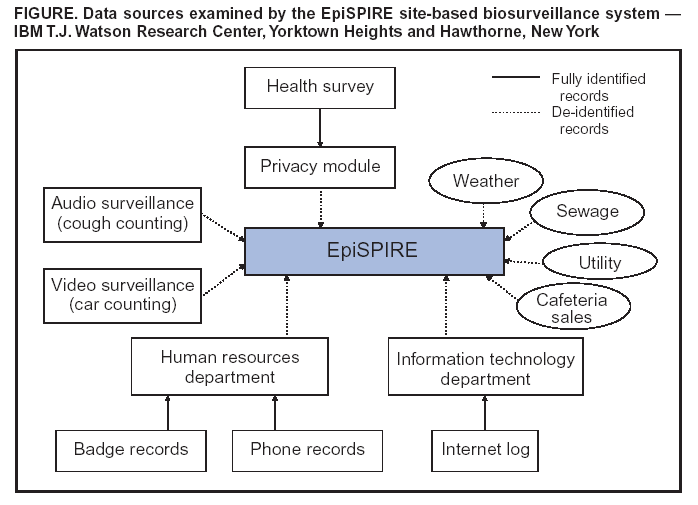 |
|
|
|
|
|
|
| ||||||||||
|
|
|
|
|
|
|
||||
| ||||||||||
|
|
|
|
|
Persons using assistive technology might not be able to fully access information in this file. For assistance, please send e-mail to: mmwrq@cdc.gov. Type 508 Accommodation and the title of the report in the subject line of e-mail. Site-Based Biosurveillance*Chung-Sheng Li,1 C. Aggarwal,1 M. Campbell,1 Y. Chang,1 M. Hill,1 V. Iyengar,1 M. Naphade,1 J. Smith,1 M. Wang,1 K. Wu,1 P. Yu,1 A. Kress2
Corresponding author: Murray Campbell, IBM T.J. Watson Research Center, P.O. Box 218, Yorktown Heights, NY 10598. Telephone: 914-945-2942; Fax: 914-945-4077; E-mail: mcam@us.ibm.com. AbstractIntroduction: Site-based biosurveillance presents multiple opportunities for data collection that might not be available in less permissive environments. Objectives: This study examined the potential for using site-based biosurveillance --- the monitoring of a geographically contained site (e.g., work site, university campus, or military base) --- to detect disease outbreaks. Methods: Available data sources were catalogued, and an initial characterization of those data sources with respect to their value for disease surveillance was performed. A system (EpiSPIRE) for managing surveillance data (both site and regional) and outbreak-detection algorithms was also developed (Figure). The study was conducted at the IBM T.J. Watson Research Center, which is located at two sites 10 miles apart: Yorktown Heights, New York, and Hawthorne, New York. Data collection started in late 2001. Physician office-visit data for respiratory illness in the Westchester County area was supplied by Surveillance Data, Inc., for use in evaluating the site data sources. Results: Two site data sources were identified as most promising: 1) a survey of self-assessed health and 2) phone calls to medically related phone numbers. Absenteeism, Internet queries, cafeteria sales, and traffic data, though less promising, are worthy of further study. Cough counting and utility usage appear to have less value for site surveillance. * This work is supported by the Air Force Research Laboratory (AFRL)/Defense Advanced Research Projects Agency (DARPA) under AFRL Contract No. F30602--01--C--0184. Any opinions, findings, conclusions, or recommendations expressed in this material are those of the authors and do not necessarily reflect the views of the AFRL or DARPA. Figure Return to top.
Disclaimer All MMWR HTML versions of articles are electronic conversions from ASCII text into HTML. This conversion may have resulted in character translation or format errors in the HTML version. Users should not rely on this HTML document, but are referred to the electronic PDF version and/or the original MMWR paper copy for the official text, figures, and tables. An original paper copy of this issue can be obtained from the Superintendent of Documents, U.S. Government Printing Office (GPO), Washington, DC 20402-9371; telephone: (202) 512-1800. Contact GPO for current prices. **Questions or messages regarding errors in formatting should be addressed to mmwrq@cdc.gov.Page converted: 9/14/2004 |
|||||||||
This page last reviewed 9/14/2004
|